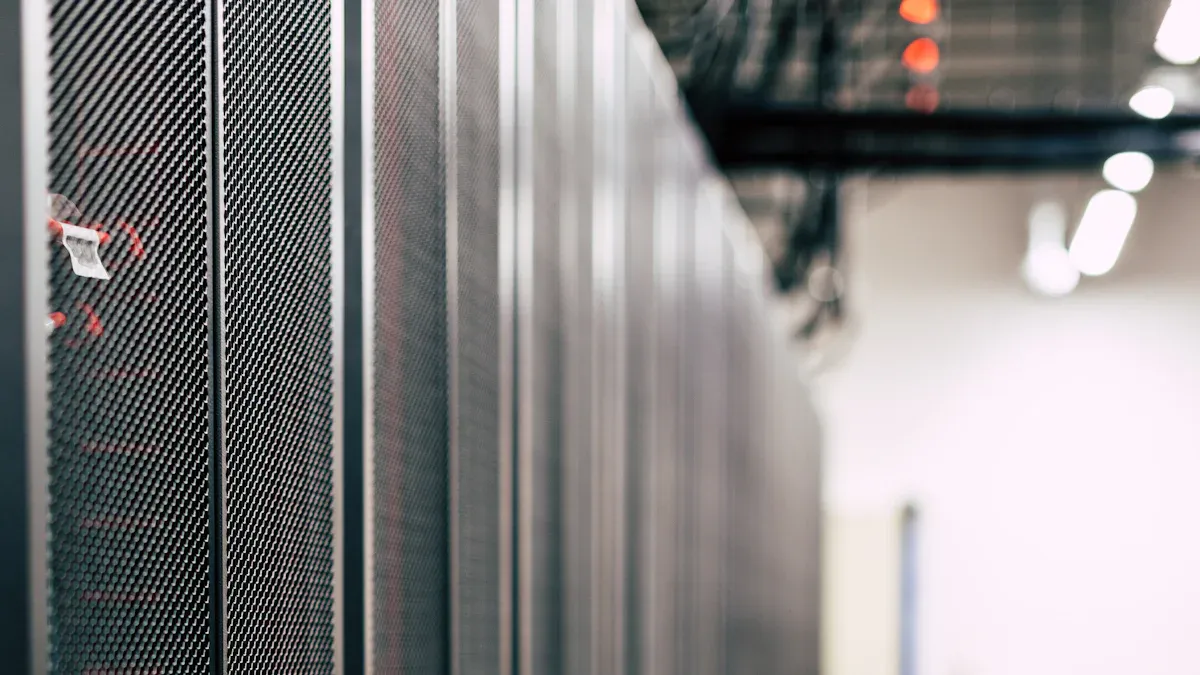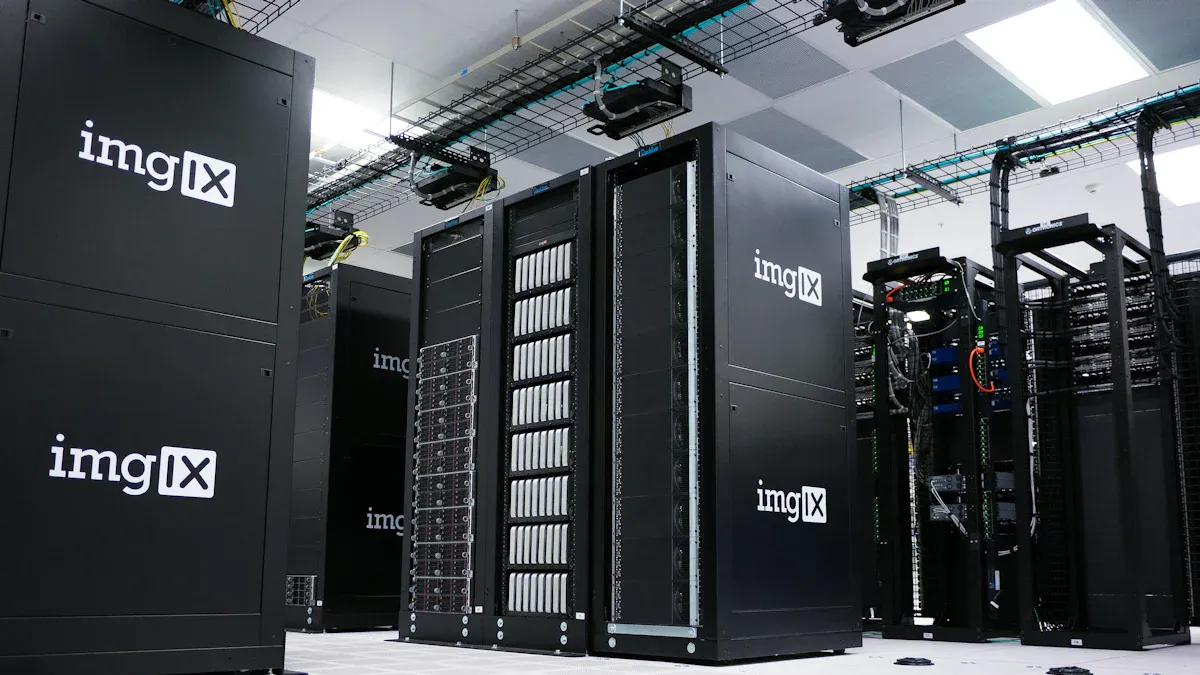
Data centers in the Middle East face high energy costs and extreme temperatures. Advanced PDU solutions deliver precise power management, helping operators optimize energy use and maintain reliability. Intelligent systems provide real-time monitoring. Operators reduce downtime and operational costs while supporting digital growth.
Key Takeaways
- Advanced PDUs help data centers in the Middle East cut energy costs and improve power management by providing real-time monitoring and smart control.
- These PDUs protect equipment from extreme heat by detecting hot spots and supporting efficient cooling, which keeps data centers reliable and safe.
- Flexible and intelligent PDUs support fast digital growth by allowing easy upgrades and reducing downtime, helping data centers stay efficient and ready for the future.
Addressing Middle East Data Center Challenges with Advanced PDU Solutions

PDU Strategies for High Energy Costs and Power Management
Data centers in the Middle East operate in a landscape defined by high capital investment, operational cost constraints, and regulatory complexity. Operators face significant upfront costs for upgrading power, cooling, and security systems. Ongoing expenses in energy consumption and infrastructure upgrades create persistent challenges. The following table summarizes these regional dynamics:
| Aspect | Evidence Summary |
|---|---|
| High Capital Investment | Data centers in the Middle East face significant upfront costs for upgrading power, cooling, and security systems, making renovations costly and challenging, especially for smaller operators. |
| Operational Cost Constraints | High expenses in energy consumption and infrastructure upgrades create ongoing operational challenges. |
| Energy Consumption & Efficiency | Rising energy use drives demand for energy-efficient solutions such as advanced cooling, power management, and renewable energy integration to reduce costs. |
| Regulatory Complexity | Strict and evolving data protection laws (e.g., Saudi Arabia’s Personal Data Protection Law) require costly compliance upgrades, adding to operational burdens. |
| Regional Examples – UAE | Largest market share (~30%), investing in solar power, liquid cooling, AI-driven automation to improve energy efficiency and reduce operational costs. |
| Regional Examples – KSA | Second largest (~25%), driven by Vision 2030, focusing on scalable, energy-efficient data centers with enhanced security and power distribution upgrades. |
| Market Trends | Integration of AI, automation, and smart infrastructure optimizes energy use and operational efficiency, addressing high energy costs and operational challenges. |
Operators deploy advanced PDU solutions to address these challenges. High-efficiency PDUs reduce energy losses by 2-3% compared to conventional units. Smart PDUs monitor power usage, supporting the reduction of operational costs. Power Usage Effectiveness (PUE) serves as a primary key performance indicator, with a target of 1.5 or lower indicating optimal energy efficiency. Data Center Infrastructure Efficiency (DCiE) provides a complementary metric, expressing the percentage of power used directly by IT equipment. These KPIs help operators measure and improve energy efficiency, ensuring that investments in advanced PDU technology deliver measurable results.
Tip: Regularly monitoring PUE and DCiE helps operators identify inefficiencies and optimize power distribution strategies.
PDU Adaptations for Extreme Temperatures
Extreme temperatures in the Middle East present unique operational risks for data centers. High ambient heat increases cooling demands and can threaten equipment reliability. Advanced PDU solutions play a critical role in maintaining stable operations under these conditions. Intelligent PDUs provide real-time monitoring of power consumption and environmental conditions at both the rack and outlet levels. This capability enables early detection of hot spots and supports compliance with ASHRAE temperature and humidity standards.
Operators use the following performance indicators to ensure optimal operation in harsh environments:
- Cabinets compliant with ASHRAE temperature and humidity standards
- Hot spots occurrence and duration
- Peak load per cabinet over the last 30 days
By leveraging these metrics, data center managers can proactively address cooling inefficiencies and prevent equipment failures. Advanced PDUs also support integration with smart cooling systems, enabling dynamic adjustments based on real-time data. This approach enhances both energy efficiency and equipment longevity.
PDU Support for Rapid Digital Expansion
The Middle East continues to experience rapid digital growth, driven by cloud adoption, AI, and digital transformation initiatives. Data centers must scale quickly to meet rising demand while maintaining reliability and efficiency. Advanced PDU solutions offer the flexibility and adaptability required for this environment. Industry reports highlight how global and regional players invest in research and development to customize PDUs for local requirements, such as varying voltage needs and supply chain uncertainties.
For example, modular PDUs with triple-output voltage transformers allow operators to configure voltage settings post-deployment. This flexibility supports bulk procurement and rapid deployment, even when site-specific voltage requirements remain uncertain. Isolated PDU designs enable maintenance or tenant load modifications without disrupting other tenants, reducing downtime risks in multi-tenant environments.
Operators track the following KPIs to measure the effectiveness of PDU strategies during expansion:
- Power distribution efficiency
- Cabinet power failover redundancy compliance (targeting 100% compliance)
- Peak load per cabinet
These metrics ensure that data centers can expand capacity while maintaining high standards of reliability and operational efficiency. Advanced PDU solutions empower operators to adapt quickly, minimize risks, and support the region’s digital transformation.
Key Features and Benefits of Advanced PDU Technologies

Real-Time Monitoring and Remote Management with PDUs
Advanced PDU technologies transform data center operations by enabling real-time monitoring and remote management. Intelligent PDUs deliver detailed power metrics, which help operators identify idle servers and optimize resource allocation. These systems provide instant access to power usage data at both the unit and outlet levels, allowing teams to pinpoint inefficiencies and take corrective action quickly.
Operators benefit from several features:
- Real-time monitoring and remote access support high-density and geographically dispersed data centers.
- Integration with environmental sensors, such as temperature and humidity detectors, enables proactive management and predictive maintenance.
- User-defined alarms and threshold-based alerts notify teams of abnormal power consumption, reducing downtime risk.
- Remote rebooting and outlet-level control streamline maintenance and minimize the need for on-site interventions.
- Load balancing features prevent power overloads and optimize energy distribution, reducing the likelihood of outages.
Research shows that intelligent PDUs can reduce energy usage by up to 20% in optimized environments. These capabilities also speed up maintenance response times by 40% and cut downtime by as much as 20%. Operators who leverage remote management features save on operational costs and improve overall efficiency. Real-world case studies highlight how these technologies support disaster recovery and deliver significant energy cost savings.
Tip: Deploying intelligent PDUs with IoT integration and cloud-based monitoring enables predictive maintenance and maximizes uptime.
Integration of PDUs with Renewable Energy and DCIM
Modern data centers increasingly rely on renewable energy sources and advanced management software to meet sustainability goals. Advanced PDUs play a crucial role in this transition by integrating seamlessly with renewable energy systems and Data Center Infrastructure Management (DCIM) platforms. This integration allows operators to monitor and control energy flows from solar, wind, and smart grid sources, ensuring uninterrupted power supply and efficient energy use.
| Statistic / Example | Description |
|---|---|
| 25% Market Share in California | California leads the US Data Center Power Management Market, driven by renewable energy integration and sustainability efforts. |
| Microsoft & Brookfield Renewable Partners | Microsoft powers its US and Europe data centers with renewable energy, demonstrating large-scale adoption of sustainable practices. |
| Adoption of Intelligent PDUs & AI-driven Systems | Intelligent PDUs combined with AI and real-time monitoring software optimize energy consumption and improve operational resilience. |
| Market Growth Drivers | The push for energy efficiency and sustainability drives adoption of renewable energy, smart grids, UPS systems, and advanced cooling solutions. |
| Industry Leaders | Companies like Emerson Electric, Schneider Electric, Eaton Corporation, and Dell offer integrated solutions that combine PDUs, UPS, and DCIM software. |
| Technological Advancements | Innovations in power electronics and digital technologies enable precise energy flow control and reliable handling of power fluctuations from renewables. |
Operators use these integrated systems to automate power management, balance loads, and plan capacity more effectively. The result is a data center environment that supports both operational efficiency and environmental responsibility.
Enhancing Reliability, Uptime, and Sustainability with PDUs
Reliability and uptime remain top priorities for data center operators. Advanced PDUs enhance these metrics by providing environmental monitoring, individual outlet metering, and real-time alerts. Integration with DCIM systems enables automated power management and capacity planning, supporting sustainable operations.
Operators experience several benefits:
- High power quality at the rack level prevents downtime and protects sensitive equipment.
- Surge protection and redundancy features reduce downtime risks and support service level agreement (SLA) compliance.
- Efficient power distribution lowers energy consumption and operational costs, contributing to sustainability.
- Proactive power management allows quick responses to power issues, optimizing performance.
A multinational corporation reduced energy costs by 30% within the first year of deploying intelligent PDUs, thanks to real-time monitoring and detection of power inefficiencies. Another example comes from eBay’s South Jordan, Utah data center, which achieved Tier IV reliability and LEED Gold certification. By consolidating data centers and implementing energy-efficient infrastructure alongside intelligent PDUs, eBay reduced operating costs by 50% and maintained a Power Usage Effectiveness (PUE) of 1.4. These results demonstrate how advanced PDUs support operational agility, minimize faults, and optimize energy use in mission-critical environments.
Note: Investing in advanced PDUs not only improves reliability and uptime but also helps data centers achieve their sustainability targets.
Advanced PDU solutions empower Middle Eastern data centers to achieve greater efficiency, cost savings, and sustainability. Operators benefit from real-time monitoring, predictive maintenance, and remote management. These features reduce downtime, optimize energy use, and support rapid digital growth, ensuring data centers remain resilient and future-ready.
FAQ
What is an advanced PDU?
An advanced PDU is a power distribution unit with intelligent features. It provides real-time monitoring, remote management, and supports efficient power usage in data centers.
How do PDUs help reduce energy costs?
Operators use intelligent PDUs to track power consumption. They identify inefficiencies, optimize energy distribution, and lower operational expenses through precise control and monitoring.
Can advanced PDUs support renewable energy integration?
Yes. Advanced PDUs integrate with renewable energy systems and DCIM platforms. They help manage energy flows from solar or wind sources, supporting sustainability goals.
Post time: Jul-06-2025





